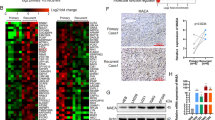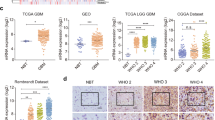Abstract
Protein lysine succinylation (Ksucc) represents an important regulatory mechanism of tumor development. In this work, the difference of protein Ksucc between HCMEC/D3 co-cultured with U87 (glioma endothelia cells, GEC) and without U87 (normal endothelia cells, NEC) was investigated using TMT labeling and affinity enrichment followed by high-resolution LC-MS/MS analysis. Interestingly, TAGLN2 was highly succinylated at K40 in GEC (15.36 folds vs. NEC). Compared to the Vector group, TAGLN2WT and a succinylation-mimetic TAGLN2K40E greatly promoted the angiogenesis of glioma in vitro and in vivo. Furthermore, the adhesion and metastasis of U87 co-cultured with GEC in the TAGLN2WT or TAGLN2K40E group were also significantly promoted. This was consistent with the increased expression of VE-cadherin and actin cytoskeleton remodeling induced by TAGLN2 K40succ in GEC. In addition, high K40succ of TAGLN2 was associated with poor prognosis in patients with glioma. Overexpression of TAGLN2K40E also markedly promoted the proliferation and migration of glioma cells, further analysis of in vivo xenograft tumors showed that there was a significant decrease in tumor size and angiogenesis in the TAGLN2K40R group. Notably, the co-localization of TMSB4X and TAGLN2 mainly in the nucleus and cytoplasm of glioma cells was detected by immunofluorescence staining. We identified TMSB4X as a potential target of TAGLN2, which was proved to interact with TAGLN2WT rather than TAGLN2K40A. And the inhibition of TMSB4X could markedly attenuate the proliferation and migration of glioma cells induced by TAGLN2 K40succ. The results revealed K40succ of TAGLN2 could be a novelty diagnosis and therapeutic target for gliomas.






Similar content being viewed by others
Data availability
Quantitative analysis of global proteome in HCMEC/D3 and proteomic quantification of lysine succinylation in human project accession: PXD005001. All other data supporting the findings of this study and the experimental materials generated in this study are available from the corresponding authors upon request.
References
Jhaveri N, Chen TC, Hofman FM. Tumor vasculature and glioma stem cells: contributions to glioma progression. Cancer Lett. 2016;380:545–51.
Ahir BK, Engelhard HH, Lakka SS. Tumor development and angiogenesis in adult brain tumor: glioblastoma. Mol Neurobiol. 2020;57:2461–78.
Onishi M, Ichikawa T, Kurozumi K, Date I. Angiogenesis and invasion in glioma. Brain Tumor Pathol. 2011;28:13–24.
Alleyn M, Breitzig M, Lockey R, Kolliputi N. The dawn of succinylation: a posttranslational modification. Am J Physiol Cell Physiol. 2018;314:C228–32.
Olsen JV, Mann M. Status of large-scale analysis of post-translational modifications by mass spectrometry. Mol Cell Proteom. 2013;12:3444–52.
Zhang Z, Tan M, **e Z, Dai L, Chen Y, Zhao Y. Identification of lysine succinylation as a new post-translational modification. Nat Chem Biol. 2011;7:58–63.
Du J, Zhou Y, Su X, Yu JJ, Khan S, Jiang H, et al. Sirt5 is a NAD-dependent protein lysine demalonylase and desuccinylase. Science. 2011;334:806–9.
Lin ZF, Xu HB, Wang JY, Lin Q, Ruan Z, Liu FB, et al. SIRT5 desuccinylates and activates SOD1 to eliminate ROS. Biochem Biophys Res Commun. 2013;441:191–5.
Kim HR, Park JS, Karabulut H, Yasmin F, Jun CD. Transgelin-2: a double-edged sword in immunity and cancer metastasis. Front Cell Dev Biol. 2021;9:606149.
Han MZ, Xu R, Xu YY, Zhang X, Ni SL, Huang B, et al. TAGLN2 is a candidate prognostic biomarker promoting tumorigenesis in human gliomas. J Exp Clin Cancer Res. 2017;36:155.
Kim HR, Kwon MS, Lee S, Mun Y, Lee KS, Kim CH, et al. TAGLN2 polymerizes G-actin in a low ionic state but blocks Arp2/3-nucleated actin branching in physiological conditions. Sci Rep. 2018;8:5503.
Lamalice L, Le Boeuf F, Huot J. Endothelial cell migration during angiogenesis. Circ Res. 2007;100:782–94.
Dejana E. Endothelial cell-cell junctions: happy together. Nat Rev Mol Cell Biol. 2004;5:261–70.
Padmanabhan K, Grobe H, Cohen J, Soffer A, Mahly A, Adir O, et al. Thymosin beta4 is essential for adherens junction stability and epidermal planar cell polarity. Development. 2020;147:dev193425.
Yang Y, Gibson GE. Succinylation links metabolism to protein functions. Neurochem Res. 2019;44:2346–59.
Sreedhar A, Wiese EK, Hitosugi T. Enzymatic and metabolic regulation of lysine succinylation. Genes Dis 2020;7:166–71.
Zeng Z, Li Y, Pan Y, Lan X, Song F, Sun J, et al. Cancer-derived exosomal miR-25-3p promotes pre-metastatic niche formation by inducing vascular permeability and angiogenesis. Nat Commun. 2018;9:5395.
Merino F, Pospich S, Raunser S. Towards a structural understanding of the remodeling of the actin cytoskeleton. Semin Cell Dev Biol. 2020;102:51–64.
Na BR, Kim HR, Piragyte I, Oh HM, Kwon MS, Akber U, et al. TAGLN2 regulates T cell activation by stabilizing the actin cytoskeleton at the immunological synapse. J Cell Biol. 2015;209:143–62.
Dvorakova M, Nenutil R, Bouchal P. Transgelins, cytoskeletal proteins implicated in different aspects of cancer development. Expert Rev Proteom. 2014;11:149–65.
**ao Y, Li Y, Han J, Pan Y, Tie L, Li X. Transgelin 2 participates in lovastatin-induced anti-angiogenic effects in endothelial cells through a phosphorylated myosin light chain-related mechanism. PLoS ONE. 2012;7:e46510.
** H, Cheng X, Pei Y, Fu J, Lyu Z, Peng H, et al. Identification and verification of transgelin-2 as a potential biomarker of tumor-derived lung-cancer endothelial cells by comparative proteomics. J Proteom. 2016;136:77–88.
Fonseca CG, Barbacena P, Franco CA. Endothelial cells on the move: dynamics in vascular morphogenesis and disease. Vasc Biol. 2020;2:H29–43.
Svitkina T. The actin cytoskeleton and actin-based motility. Cold Spring Harb Perspect Biol. 2018;10:a018267.
Yin LM, Ulloa L, Yang YQ. Transgelin-2: biochemical and clinical implications in cancer and asthma. Trends Biochem Sci. 2019;44:885–96.
Zeng C, Zhang H. Mechanisms of transgelin-2 in tumorigenesis. Disco Med. 2021;32:23–8.
Jang SY, Jang SW, Ko J. Regulation of ADP-ribosylation factor 4 expression by small leucine zipper protein and involvement in breast cancer cell migration. Cancer Lett. 2012;314:185–97.
Makowiecka A, Malek N, Mazurkiewicz E, Mrowczynska E, Nowak D, Mazur AJ. Thymosin beta4 regulates focal adhesion formation in human melanoma cells and affects their migration and invasion. Front Cell Dev Biol. 2019;7:304.
Teng Y, Loveless R, Benson EM, Sun L, Shull AY, Shay C. SHOX2 cooperates with STAT3 to promote breast cancer metastasis through the transcriptional activation of WASF3. J Exp Clin Cancer Res. 2021;40:274.
Murcia-Belmonte V, Esteban PF, Martinez-Hernandez J, Gruart A, Lujan R, Delgado-Garcia JM, et al. Anosmin-1 over-expression regulates oligodendrocyte precursor cell proliferation, migration and myelin sheath thickness. Brain Struct Funct. 2016;221:1365–85.
Xue B, Leyrat C, Grimes JM, Robinson RC. Structural basis of thymosin-beta4/profilin exchange leading to actin filament polymerization. Proc Natl Acad Sci USA. 2014;111:E4596–605.
Lee CW, Vitriol EA, Shim S, Wise AL, Velayutham RP, Zheng JQ. Dynamic localization of G-actin during membrane protrusion in neuronal motility. Curr Biol. 2013;23:1046–56.
Wirsching HG, Krishnan S, Florea AM, Frei K, Krayenbuhl N, Hasenbach K, et al. Thymosin beta 4 gene silencing decreases stemness and invasiveness in glioblastoma. Brain. 2014;137:433–48.
Vitriol EA, McMillen LM, Kapustina M, Gomez SM, Vavylonis D, Zheng JQ. Two functionally distinct sources of actin monomers supply the leading edge of lamellipodia. Cell Rep. 2015;11:433–45.
Zhang C, Zhang X, Wang J, Di F, Xue Y, Lin X, et al. Lnc00462717 regulates the permeability of the blood-brain tumor barrier through interaction with PTBP1 to inhibit the miR-186-5p/Occludin signaling pathway. FASEB J. 2020;34:9941–58.
Jia P, He J, Li Z, Wang J, Jia L, Hao R, et al. Profiling of blood-brain barrier disruption in mouse intracerebral hemorrhage models: collagenase injection vs. autologous arterial whole blood infusion. Front Cell Neurosci. 2021;15:699736.
Li Q, Lan X, Han X, Wang J. Expression of Tmem119/Sall1 and Ccr2/CD69 in FACS-sorted microglia- and monocyte/macrophage-enriched cell populations after intracerebral hemorrhage. Front Cell Neurosci. 2018;12:520.
Acknowledgements
We thank PTM Biolabs (Hangzhou, China) for help and support in the Proteomic Quantification of Lysine Succinylation. This work was supported by the National Natural Science Foundation of China (No. 82072793 and No. 81773289); the Natural Science Foundation for Liaoning Province (No. 2021-MS-213).
Author information
Authors and Affiliations
Contributions
Y.G. conceived and designed the research. X.Z. and J.H. performed the experiments and acquired data; D.F., X.L., C.Z., J.B., H.H., H.Z., and J.W. helped acquire data; X.Z. and J.H. analyzed the data; X.Z. and J.H. wrote the manuscript; Y.G. edited the paper and obtained funding. All authors revised the paper and approved the final version.
Corresponding author
Ethics declarations
Competing interests
The authors declare no competing interests.
Ethics
Animal procedures were approved via the Institutional Animal Care and Use Committee of Shenyang Pharmaceutical University and were processed in accordance with the guideline of the Animal Care and Use Committee of the National Institutes of Health. The use of the clinical samples was approved by the Hospital Ethics Committee of General Hospital of Northern Theater Command and carried out in accordance with the principles of the Declaration of Helsinki.
Additional information
Publisher’s note Springer Nature remains neutral with regard to jurisdictional claims in published maps and institutional affiliations.
Supplementary information
Rights and permissions
Springer Nature or its licensor holds exclusive rights to this article under a publishing agreement with the author(s) or other rightsholder(s); author self-archiving of the accepted manuscript version of this article is solely governed by the terms of such publishing agreement and applicable law.
About this article
Cite this article
Zhang, X., Han, J., fan, D. et al. Lysine-40 succinylation of TAGLN2 induces glioma angiogenesis and tumor growth through regulating TMSB4X. Cancer Gene Ther 30, 172–181 (2023). https://doi.org/10.1038/s41417-022-00534-6
Received:
Revised:
Accepted:
Published:
Issue Date:
DOI: https://doi.org/10.1038/s41417-022-00534-6
- Springer Nature America, Inc.
This article is cited by
-
A glimpse into novel acylations and their emerging role in regulating cancer metastasis
Cellular and Molecular Life Sciences (2024)
-
A single nuclear transcriptomic characterisation of mechanisms responsible for impaired angiogenesis and blood-brain barrier function in Alzheimer’s disease
Nature Communications (2024)
-
TAGLN2 Promotes the Proliferation, Migration, Invasion, and EMT of Clear Cell Renal Cell Carcinoma Through the PI3K/Akt Signaling Pathway
Biochemical Genetics (2023)




